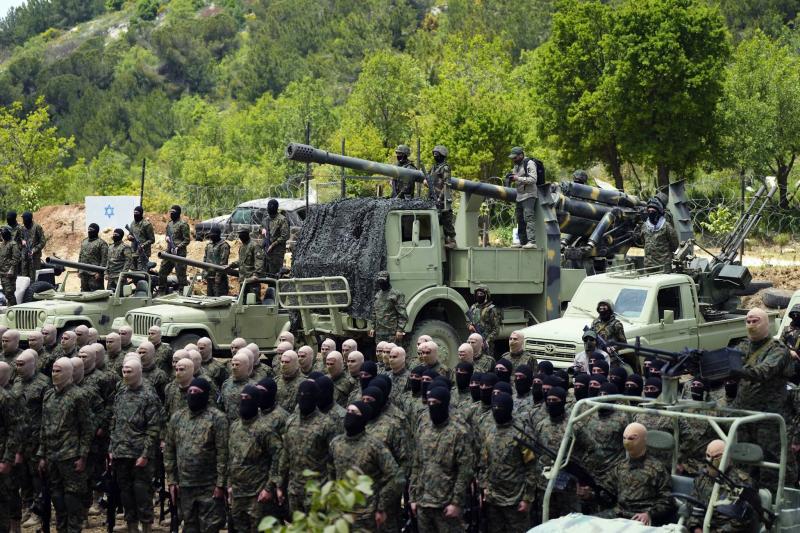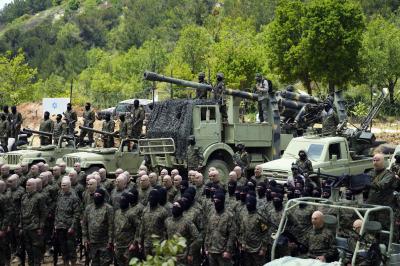For more than ten months of border conflict with Israel amidst the ongoing war in Gaza, Hezbollah has carried out hundreds of attacks to test gaps in Israeli air defenses, unveiling new weapons in response to the killing of senior commanders inside Lebanon. An Israeli government spokesperson stated last month that Hezbollah launched 6,800 rockets since the escalation began across the border. According to Dina Arqaji, a researcher at the "Control Risks" center, the group had about "15,000 rockets" in 2006, a number that has "increased by about tenfold" according to estimates reported by "AFP." Hezbollah has received large shipments of rockets and drones from Iran and has recently started producing its own weapons. The group is also distinguished by its air defense capabilities, which most militias in the region lack.
Hezbollah's arsenal includes guided and unguided missiles, anti-tank artillery, ballistic and anti-ship missiles, as well as armed drones, allowing it to reach deep into Israeli territory. The Iran-backed group has up to 150,000 rockets and shells, according to the CIA World Factbook. In 2021, Nasrallah claimed that the group had 100,000 fighters. The World Factbook's estimates for 2022 suggest that the number of fighters reached 45,000, with 20,000 of them being full-time.
**Unguided Munitions**
Most of Hezbollah's weapons are unguided munitions of a lower grade, which could pose a threat to Israeli air defense systems if fired in large numbers. More concerning for Israel is the precision munitions the group claims to possess, according to "The Washington Post." Unguided munitions made up the majority of Hezbollah's rocket arsenal during its war with Israel in 2006, when it launched around 4,000 rockets at Israel, mostly Katyusha rockets with a range of up to 30 kilometers. Hezbollah maintains a tight cover over its arsenal, leaving weapons experts to guess the full extent of its capabilities. Much of what is known publicly comes from statements by the group and its leader Nasrallah, who claims that his fighters have used "only a fraction of our weapons" in the escalation of attacks on northern Israel since October 8. Nasrallah stated that the biggest change in the group's arsenal since 2006 is its expansion in precision-guided systems and that Hezbollah has the capability to equip missiles with guidance systems within Lebanon.
Hezbollah possesses Iranian-made types of missiles like Raad, Fajr, and Zalzal. Among the missiles fired at Israel during the Gaza war since October have been Katyusha and Burkan missiles, with explosive loads ranging from 300 to 500 kilograms. The group used Iranian-made Falaq 2 missiles for the first time in June, which can carry a larger warhead than the previously used Falaq 1 missiles.
**Missiles and Shells**
Hezbollah began striking northern Israel for the first time a day after militants led by Hamas infiltrated the country on October 8, initially using various short-range missiles and shells targeting tanks and other technical equipment near the border before advancing to attacks on military barracks and bases. On November 11, Nasrallah revealed that Hezbollah was using Burkan missiles. According to Fabian Hienz, a defense and military analyst at the International Institute for Strategic Studies, Burkan has become "a prominent weapon for Iran-backed groups in the region," as reported by "The Washington Post." The long-range Falaq missile with an enhanced warhead has also been used by Hezbollah. According to an interview broadcasted by Hezbollah's Al-Manar channel with an artillery unit officer on July 6, the Falaq-1 missile can reach targets up to 11 kilometers deep.
Hezbollah, which has repeatedly stated since the escalation with Israel that it is using Falaq-1 missiles to attack military sites, also employs other more precise missiles, including anti-tank missiles like Kornet. The Israeli military accused Hezbollah on June 27 of firing a Falaq-1 missile, with a warhead weight of 53 kilograms, which landed in a football field in Majdal Shams, a town with a majority Druze population, resulting in the deaths of 12 children.
**Anti-Tank Missiles**
The group extensively used guided anti-tank missiles in the 2006 war and has again deployed guided missiles, including Russian-made Kornet missiles. During the current conflict, Hezbollah has repeatedly used Russian-made portable Kornet anti-tank missiles, according to the Associated Press. A report aired by the Iran-affiliated Al-Mayadeen channel indicated that Hezbollah also used an Iranian-made guided missile known as Almase. An Israeli Alma Center report described the Almase missile as capable of hitting targets outside the line of sight by following a curved path, allowing it to strike from above. The report added that this missile is part of a family of weapons made by Iran through reverse engineering based on Israel's Spike missile family.
**Anti-Aircraft Missiles**
It is unusual for non-state actors like Hezbollah to possess air defense capabilities, indicating the group’s preparedness for war. According to "The Washington Post," Hienz reported that Hezbollah has used surface-to-air munitions, most notably the Iranian-made 358 anti-aircraft missile, to shoot down Israeli drones. On at least two occasions, the group claimed to have used more advanced munitions, likely the Iranian-made Saegheh-2 missile, which is radar-guided and can reach targets at nearly 90,000 feet against Israeli fighter jets, forcing them to retreat. Hezbollah has shot down several Israeli drones during this conflict using surface-to-air missiles, including drones of the Hermes 450 and Hermes 900 models. Despite longstanding belief that Hezbollah possessed anti-aircraft missiles, this is the first time the group has used such weapons.
**Drones**
For several months, Hezbollah has intensively used drones in its attacks on Israeli military sites, generally near the border and sometimes deeper within Israel. Last month, the group released three video clips taken by its drones, showing a comprehensive survey of sensitive Israeli targets, the latest being the Ramat David base in central Israel on July 23. Hezbollah’s arsenal includes locally assembled drones such as Ayoub and Marsad models, which analysts say can be produced cheaply and in large quantities. The group also possesses Shahed 136 and other Iranian-manufactured drones guided by both electro-optical and GPS systems. It seems that Israel has increased its jamming operations in Lebanon, disrupting GPS services.
Throughout the past nine months of war, nearly every Lebanese has been affected by the ongoing GPS jamming in Lebanon. As military priorities and considerations take precedence over everything else between Lebanon and Israel amid the escalating confrontation between Hezbollah and the Israeli army, the margin for civilian activities shrinks. The airspace is restricted for civilian aircraft in favor of military aviation, drones, and missiles, while maritime navigation is confined for the benefit of military vessels, and towns and cities on both sides of the border have been abandoned by their residents, turning into battlegrounds for soldiers and fighters under the threat of mutual bombardment.
**Anti-Ship Missiles**
Hezbollah first revealed it had anti-ship missiles in 2006 when it struck an Israeli warship 16 kilometers off the coast, resulting in the deaths of four Israelis and damage to the ship. Sources knowledgeable about Hezbollah's arsenal indicate that it has acquired the Russian-made Yakhont anti-ship missile since the 2006 war, which has a range of up to 300 kilometers. Hezbollah has never confirmed possessing this weapon. Hienz points out that Hezbollah is secretive about its arsenal, noting that it took 13 years for the group to reveal its use of the C-802 missile to sink an Israeli ship in 2006. A "Washington Post" analysis suggests that if a full-scale war were to occur, Israel's Iron Dome system might not withstand intense attacks involving the simultaneous launch of hundreds of small missiles, especially since Israel has already exhausted many of the interceptor missiles of the Iron Dome during the war in Gaza.




